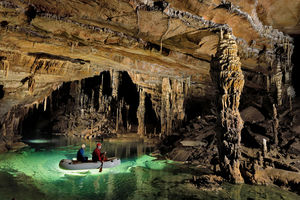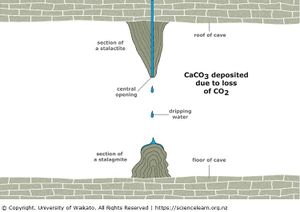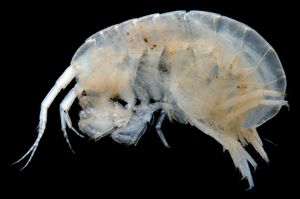Subterranean Ecology

Subterranean ecology is a branch of biology of which studies the interaction of organisms under the earth’s surface. [4] Subterranean environments include places like caves, underground waters, chasms, rock overhands, etc. Caves are the most promiminant location to find a vast amount of subterranean organisms interacting with each other. This epigean realm has yet to be fully understood and is mostly characterized as locations with little to no light. Total darkness is common within these environments and gives organisms a challenge to live without the sun. [5] Subterranean fauna mostly consists of arthropods, invertebrates, and some vertebrates such as cave salamanders. There is much to be learned about subterranean ecology due to its difficulty to explore its environments.
Caves

Caves are the most common environments for subterranean ecology. A cave, also called cavers, is a natural opening in the earth, formed through various types of natural processes. Most caves are formed by a chemical reaction between groundwater and bedrock composed of limestone dolomite. Rain water picks up carbon dioxide from the wait as it penetrates the soil, turning into a weak acid.[2]
The acid-forming reaction is: H2O + CO2 --> H2CO3 (carbonic acid).
The solution of water and carbonic acid then seeps down into the limestone. The acid reacts with the calcite to dissolve it in the liquid.
CaCO3 + H2CO3 --> Ca+2 + 2(HCO3-) (calcium bicarbonate solution). [3]
Over time, the limestone or dolostone dissolves, creating massive pockets under the earth’s surface. Cave passages usually move through the water table of an aquifer. Water from an aquifer can reroute its path into the caves, which will dictate if the cave will be wet or dry. [3]
Subterranean fauna

Subterranean fauna are decribed as organisms that live below the surface of the earth. They are divided into two groups: troglofauna and stygofuana. [1] Trogofauna are air breathing and live in caves and voids. Stygofauna are aquatic and live in groundwater. Most fauna have reduced pigment and non functioning eyes. Invertebrates dominate subterranean fauna. Some vertebrates, like the blind snake, or the pilabra can be found in these special environments. Troglofauna include, millipedes, beetles, crickets and other organisms that are able to live in caves. Troglofuana represent an example of adaptation in extreme environments Stygofauna live in freshwater aquifers. Stygofauna include gastropods, isopods, fishes, and salamanders. Stygofuana are able to navigate through the aquifer without any vision. [6]

Stygofauna
Stygofuna play an important role in prokaryotic transport in freshwater reserves. they enhance the transport of prokaryotes through aquifers. prokaryotes associated with stygofauna may up to 5 orders of magnitude higher in abudnace and transported up to 34x faster than bulk groundflow. As a community, prokaryotes play a role in the biosphere and purifying groundwater. Stygofauna's movement and excretion in groundwater systmes are thougth to meditate transfer of organic matter through the aquifer.
Trogofauna
There are about 9882 individual species of troglofauna. troglofauna include spriders, insects. myriapods and many others. due to their lack of eyesight, theyy have a heightened sense of hearing, touch, and smell. troglofauna thrive in humid environments and when a cave becomes dry they become agitated. troglofauna have very low metabolisms which allows them to live in conditions where food is scarce.They were discovered in a series of Caves in the Sierra Nevada mountains. birds and bats in caves prey on troglofauna. Floods can also pose a threat to them
References
1. Subterranean Fauna (stygofauna and troglofauna). (n.d.). Retrieved from http://www.bennelongia.com.au/services/subterranean-fauna/
2. How caves form. (n.d.). Retrieved from https://www.bgs.ac.uk/mendips/caveskarst/caveform.htm
3. Cave Geology in Depth. (n.d.). Retrieved from https://www.nps.gov/grba/learn/nature/cave-geology-in-depth.htm
4. Shone, R. (2017, November 08). Go Inside These World-Famous, Rarely Seen River Caves. Retrieved from https://www.nationalgeographic.com/adventure/destinations/europe/slovenia/photos-hidden-river-caves/
5. Living in the dark. (2014, August 14). Retrieved from https://blog.oup.com/2014/08/dark-habitats-convergent-morphology/
6. Sumo Group - Perth Digital Agency. (n.d.). About Stygofauna. Retrieved from http://www.subterraneanecology.com.au/knowledge-publications/about-stygofauna